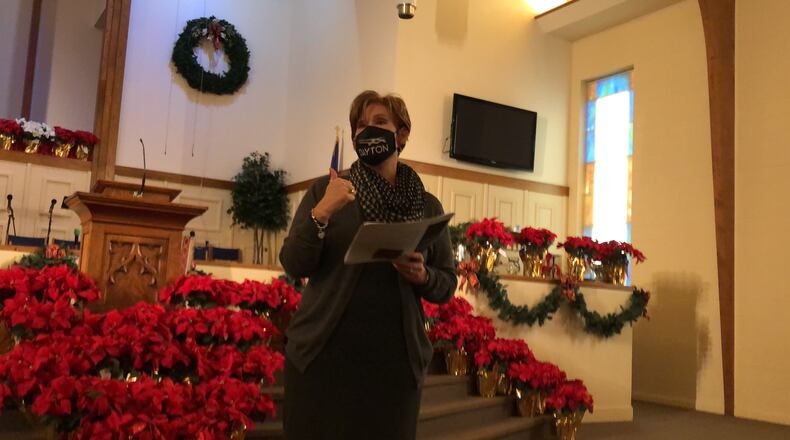The city proposes to use the rest of the money to enhance its facilities and services and support Black and brown businesses and community and small business recovery.
Dayton officials have said this is the largest grant in the city’s history, and many people view this as a once-in-a-lifetime opportunity to improve quality of life and address disparities in the community.
“Our primary goal was really to put together a recovery plan that disrupted multi-generational poverty, income and health disparities in targeted geographies,” said Dayton City Manager Shelley Dickstein.
On Wednesday, Dickstein unveiled the city’s draft spending plan during a sparsely attended community meeting at North Dayton Baptist Church.
This was the first of four community meetings in which the city will share information about its spending proposals for its American Rescue Plan Act funds. The next meeting is at 5:30 p.m. Thursday at the Northwest Recreation Center.
The city’s recovery plan calls for putting $55 million toward improving neighborhoods, $36 million toward revenue replacement and $21.5 million toward enhancing critical services.
In neighborhoods, the city hopes to demolish blighted structures; provide funding for rehab and repair projects; reconstruct sidewalks and curbs; plant new tree lawns; upgrade parks; and support in-fill, new housing, other amenities and neighborhood businesses and services.
The city will set aside more than one quarter of its funds to plug budget holes caused by the anticipated loss of income tax collections due to work-from-home changes.
Many people telecommuted during the pandemic, and workers who do not return to the office will be taxed where they work (at home) instead of where their employers are located.
Multiple studies suggest the city will lose $10 million to $15 million annually as a result, city officials said.
Dickstein also said the city has aging facilities, especially its police and fire stations, and the city is interested in a joint fire and police station in west or northwest Dayton.
This project would serve as the demonstration model for a 20-year facility improvement master plan, she said.
“We have in Dayton very old building stock, as far as our offices go,” she said.
The newest fire station was built in the 1980s, and the police stations are of similar age, officials said.
Dickstein said the city also proposes to use $10.8 million for “catalyzing economic recovery;” $7.7 million for supporting Black and brown businesses; and $7.2 million for aiding community and small business recovery.
The city expects to invest in the Wright brothers factory site along West Third Street in West Dayton, which could include the stabilization and rehab of the hangars and new infrastructure.
A few months ago, Dayton issued notices of funding opportunities, seeking proposals that align with its priorities for the rescue funds.
The city received 170 applications requesting $308 million in funds for projects.
An advisory board scored the 93 eligible applications and the city expects to announce what projects have been recommended for funding next week, Dickstein said.
There will be additional vetting of projects in the future.
The city analyzed a variety of data to identify which of Dayton’s 56 Census tracts have the greatest need, city staff and officials said.
“The Dayton recovery plan is being developed ... using a data-driven approach that analyzes socio-economic, health and demographic data to make informed funding decisions,” said Diane Shannon, Dayton’s director of procurement, management and budget.
The city studied data about poverty, education, mental health, segregation, utilization of public assistance, rent burdens, subsidized housing, vacancy rates and other factors.
The Wolf Creek area, which is north of West Third Street near the Wright Dunbar business district, had the highest score, indicating the greatest need or the highest level of social harm, said Hilary Ross Browning, Dayton’s budget and grants supervisor.
The analysis determined Dayton has about 30 high-need Census tracts, she said, and they are primarily concentrated in west and northwest Dayton.
“This is where our dollars are going to go the furthest, because these areas have the highest need,” she said.
City of Dayton spending proposal:
$55 million for improving neighborhoods
- Demolish blighted structures
- Improve housing conditions; provide in-fill and new housing; rehab and repair
- Support neighborhood-based businesses and services
- Reconstruct sidewalks and curbs
- Plant new tree lawns
- Upgrade parks
- Provide other amenities.
$21.5 million enhancing critical services
- Address community health and crime through a new joint police-fire station with space for the community
- Improve city facilities.
$10.8 million for catalyzing economic recovery
- Invest in historic Wright factory site
- Create a first-floor fund to make loans in the city’s business districts.
$7.7 million supporting Black and brown businesses
- Establish a racial equity fund
- Create a micro-grant opportunity fund
- Assist Black and brown businesses to make capital investments.
$7.2 million aiding community and small business recovery
- Support health and wellness programs
- Incentivize savings through an earned income tax credit savings program
- Assist small businesses
- Provide educational opportunities
- Support community organizations.
$36 million for revenue replacement
- Dayton projects losing $36 million in revenue between 2022 and 2024 due to work-from-home changes stemming from the COVID-19 pandemic.
About the Author




